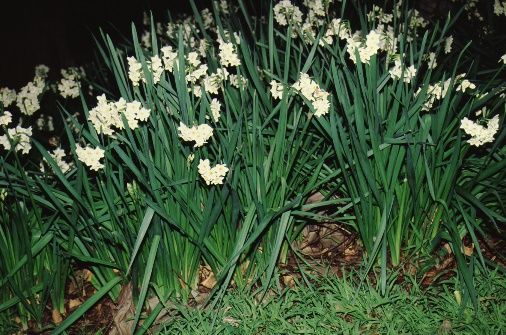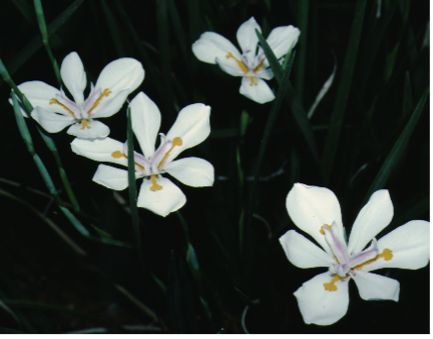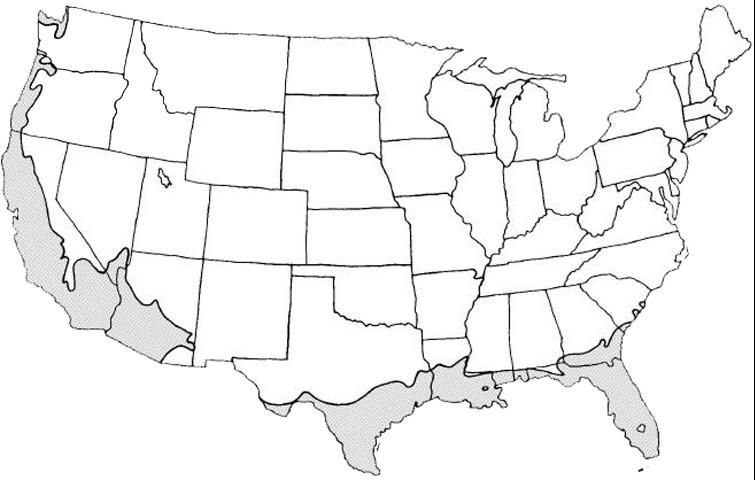Introduction
This clumping, robust perennial has stiff leaves radiating up and out in a fan-shaped pattern. The flower spikes are topped with 3inch white flowers marked with yellow and blue. Although short-lived (about 2 days), the flowers are produced sporadically throughout the year, especially in spring and early summer. Plants grow to 4 or 5 feet tall in standing water, making it ideal for water gardens and wet soil. They reach about 2 to 3 feet in soil. African iris is also attractive when used as an accent planted in a shorter groundcover.

Credit: Edward F. Gilman, UF/IFAS

Credit: Edward F. Gilman, UF/IFAS
General Information
Scientific name: Dietes vegeta
Pronunciation: dye-EE-teez VEDGE-jet-tuh
Common name(s): African iris, butterfly iris
Family: Iridaceae
Plant type: herbaceous; ornamental grass
USDA hardiness zones: 8B through 11 (Figure 3)
Planting month for zone 8: year round
Planting month for zone 9: year round
Planting month for zone 10 and 11: year round
Origin: not native to North America
Invasive potential: not known to be invasive
Uses: border; mass planting; container or above ground planter; naturalizing; water garden; accent; suitable for growing indoors
Availability: generally available in many areas within its hardiness range

Credit:
Description
Height: 2 to 6 feet
Spread: 1 to 2 feet
Plant habit: upright
Plant density: moderate
Growth rate: slow
Texture: fine
Foliage
Leaf arrangement: most emerge from the soil, usually without a stem
Leaf type: simple
Leaf margin: entire
Leaf shape: linear
Leaf venation: parallel
Leaf type and persistence: evergreen
Leaf blade length: 18 to 36 inches
Leaf color: green
Fall color: no fall color change
Fall characteristic: not showy
Flower
Flower color: white
Flower characteristic: flowers periodically throughout the year
Fruit
Fruit shape: elongated
Fruit length: .5 to 1 inch
Fruit cover: dry or hard
Fruit color: green
Fruit characteristic: persists on the plant
Trunk and Branches
Trunk/bark/branches: typically multi-trunked or clumping stems
Current year stem/twig color: not applicable
Current year stem/twig thickness: not applicable
Culture
Light requirement: plant grows in part shade/part sun
Soil tolerances: extended flooding; slightly alkaline; clay; sand; acidic; loam
Drought tolerance: moderate
Soil salt tolerances: poor
Plant spacing: 24 to 36 inches
Other
Roots: not applicable
Winter interest: plant has winter interest due to unusual form, nice persistent fruits, showy winter trunk, or winter flowers
Outstanding plant: not particularly outstanding
Pest resistance: long-term health usually not affected by pests
Use and Management
African iris will bloom best on rich, moist soil but will tolerate moderately dry soil conditions, growing in full sun to partial shade. Plants in the full sun or in sandy soil grow best with regular and frequent irrigation. Cold temperatures (below 25°F) cause leaf browning. These leaves can be removed in the spring to clean up the plant. Otherwise, African iris requires no maintenance except for a light fertilization or two each year. Frequent fertilization increases growth rate, foliage color and flower production.
The cultivar 'Johnsonii' has larger leaves and flowers.
Propagation is by seed or division of the matted clumps. Whole plants are lifted, and the rhizomes divided every three years or when new plants are needed.
Pests and Diseases
Nematodes are the main pest problem. No other problems appear to affect this durable plant.
No diseases are of major concern.